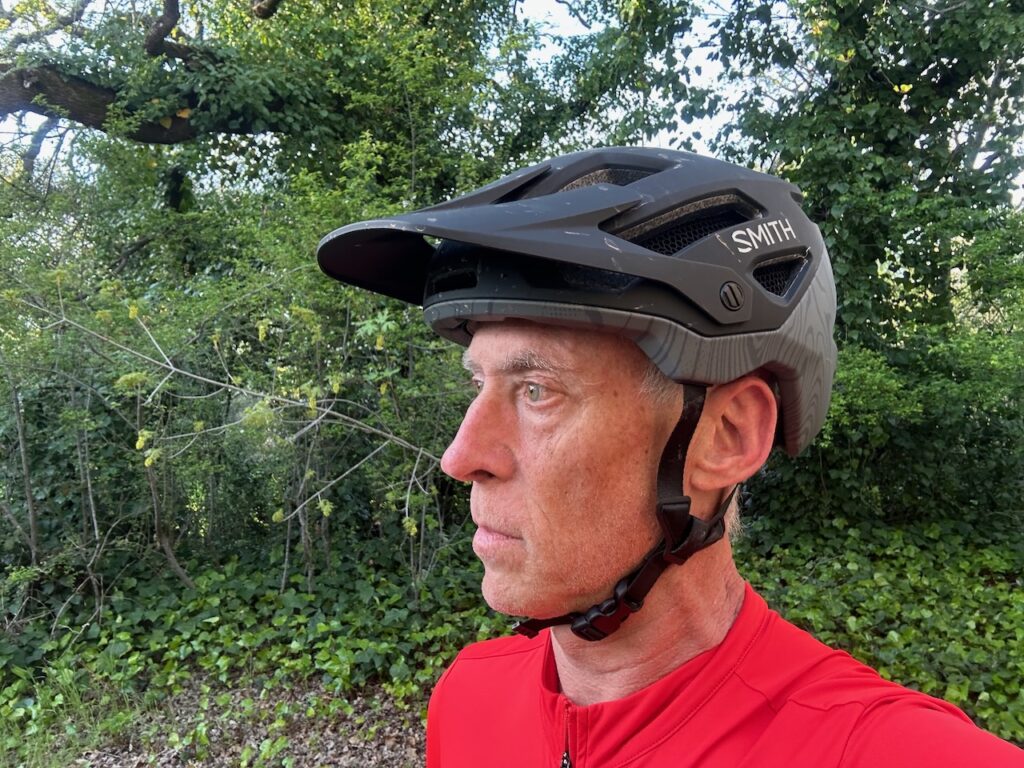I’ve been wearing the Smith Triad and Payroll helmets. The Trace is a road helmet and the Payroll is a mountain helmet with a visor. Both these are helmets that use Koroyd, the material for which Smith helmets are known, which looks like you’re looking at the end of a box of soda straws.
The first Smith helmets that I reviewed with Koroyd used so much of the material that they weren’t especially well ventilated. I got overheated on especially hot days. The Trace and Payroll feature significant vents unobscured by Koroyd, which makes a real difference in my comfort.

Both helmets also feature a MIPS liner to reduce impact severity, especially in crashes that induce rotational forces.
Both helmets come in a number of colorways, but there is a particular colorway for these two helmets that makes them noteworthy. The matte black/topo helmets are equipped with some electronics in the Vaypor adjustment dial at the back of the helmet. In fact, it’s a crash sensor with an accelerometer in it, and it’s called Aleck. Each dial has a micro-USB jack so that they can be charged. The electronics pair with a smartphone app that communicates via Bluetooth.
With Aleck, you set just how

The visor on the Payroll can be flipped up, but if you’re doing road or gravel riding, you really aren’t going to want that visor being caught by the wind and being blown back like a sail, hence the reason for the Trace.
Both helmets come in four sizes—yay—and each comes in a number of colorways, but just one—the aforementioned black with gray topo lines—if you want Aleck.
If you’re someone prone to riding by yourself for reasons of either schedule or temperament, I’d recommend picking one of these up. Crash sensors have been in the works for a while now, but most either don’t work well or are integrated into more expensive products. The Triad goes for $210 and the Payroll runs $270.
In the Aleck app, which comes in both iOS and Android versions, you can add the contacts you wish to be notified in the event you crash. And because it works via Bluetooth, pairing with your phone is relatively easy. It does mean that to receive the benefit of Aleck, you need to ride with your smartphone.
What I find remarkable about these Aleck-equipped helmets is that they offer one of the best answers to the question: What you can do to increase a rider’s safety?
Final thought: Lassie, go get help!



I picked up a Payroll last year as an iffy colorway was on sale and didn’t beat up my payroll too much (sorry) and found it to be pleasantly ventilated with an overall nice fit. There are two knocks I have against it. First the Boa saddle at the back had sharp edges that literally cut my shorn pate when I snugged it down maybe too vigorously. I remedied that somewhat with some strategically placed gaff tape, but it was only slightly less annoying. Second, and this is very subjective, but having a location for sunglasses that is easy to place and deploy while riding has become a must have for me. Yeah, I rode road/CX in the way back and became spoiled by this unwitting feature of the road lids I had. I don’t like nor use rearward facing ones. The Smith one is not technically designed for this (most helmets are not with a few notable exceptions*), but spectacles will go into the lateral front vents upside down. My complaint here is that the bottom edge of the glasses are in your field of view if you happen to look up and forward so like often. It works but isn’t ideal. 3.5 outta 5 Dio fingers. \m/ *I’ll get into those in the future.